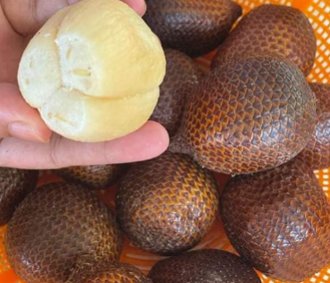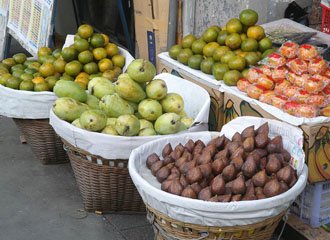Snake fruit Nutrition facts
The snake fruit, commonly known as salak, is a tropical fruit-bearing plant native to Indonesia in the Arecaceae family of palm trees. The fruit has a unique and distinctive flavor that often described as sweet with a hint of tanginess.
The fruit gets its name "snake fruit" due to its reddish-brown scaly skin, which resembles snake scales when peeled.
Scientific name: Salacca zalacca.
 |
| Snake fruit (Salak). Courtesy: Snake fruit Philippines. |
The Salacca zalacca is a tropical palm plant that thrives in warm, well-drained, sandy, or loamy soils. It typically grows to a height of 3-6 meters (10-20 feet). It has long, pinnate leaves. Salak is mostly propagated from seed. The plant requires 3- 4 years from sowing till flowering. Well-sized suckers will flower after 2- 3 years.
The fruit is small, typically 3-5 cm (1-2 inches) in diameter, appear in clusters near the base of palm stem. It has reddish-brown to dark brown scaly skin. It is typically harvested when fully ripe when the skin turns a dark brown color. The fruit is usually harvested by hand and should be handled with care to avoid damaging the delicate segments inside.
When you peel the skin, you'll find 2-3 like off-white segments inside. The fruit segments resemble garlic cloves enclosing deep-brown seed.
Snake fruit is usually eaten fresh; sweet flavored with a slight acidic tang, which can be described as a blend of pineapple, citrus and apple. Seeds usually discarded.
Varieties: There are several different varieties of Salacca zalacca, each with slightly different characteristics in terms of taste and appearance. Some well-known varieties which are often distinguished by their place of origin, flavor and fruit color. Some examples include S. zalacca are Pondoh, Salak Bali gula pasir, and Salak Bali Merah. S. wallichiana cultivar is grown in Thailand.
Health benefits of Snake fruit
Snake fruit (salak) is a good source of essential vitamins and minerals, including vitamin C, vitamin A, vitamin E, and various B vitamins. It also contains minerals like potassium, iron (32% of DRI), and calcium.
100 g fresh fruit has 77 calories and 0.4 g of protein. The natural sugars in this fruit can provide a quick energy boost, making it a good choice for a healthy snack or a pre-workout food.
Phytochemical and nutritional assessments of the pulp from mature ripe snake fruit show the presence of various bioactive compounds antioxidants, such as phenolic compounds and flavonoids. These antioxidants help protect the body's cells from damage caused by free radicals, which can contribute to various diseases and aging.
The high vitamin C content in salak can boost your immune system by supporting the production of white blood cells and enhancing your body's ability to fight off infections.
The potassium in it can help regulate blood pressure by counteracting the effects of sodium, potentially reducing the risk of hypertension and cardiovascular diseases.
Snake fruit contains dietary fiber, which can aid in digestion, promote regular bowel movements, and prevent constipation.
Snake fruit has been used in traditional medicine for its potential anti-inflammatory properties, which may help alleviate symptoms of inflammatory conditions.
The fiber content in salak can help you feel fuller for longer, potentially aiding in weight management by reducing overall calorie intake.
It contains essential minerals like calcium (28 mg) and phosphorus (18 mg), which are important for maintaining strong and healthy bones.
| Principle | Nutrient Value |
|---|---|
| Energy | 77 kcal |
| Carbohydrates | 20.9 g |
| Protein | 0.4 g |
| Cholesterol | 0 mg |
| Vitamins | |
| Vitamin C | 2 mg | Niacin | 0.6 mg |
| Riboflavin | 0.07 mg |
| Thiamin | 0.04 mg |
| Minerals | |
| Calcium | 28 mg |
| Copper | 0.08 mg |
| Iron | 4.2 mg |
| Phosphorus | 18 mg |
| Zinc | 0.2 mg |
| Phyto-nutrients | |
| Carotene-ß | 4 µg |
How to choose
 |
| Snake fruits in a market. Photo courtesy: Seika. |
The snake fruit season can vary slightly depending on the region. Fresh fruit available as early as May till September.
Look for snake fruit that has a deep reddish-brown to reddish-black skin. The skin should be firm and free from blemishes or mold. Choose fruits that are of a uniform size and shape, as this can be an indicator of quality.
Avoid those with green or yellow patches, as they may not be fully ripe. Also, stay away from overly soft or mushy, as they may be overripe and fruit with damaged or flaking scales, as this can indicate poor quality.
Storage
Snake fruit can be stored at room temperature for a few days if you plan to consume them relatively quickly. However, they are best enjoyed when fresh, so try to consume them within a day or two.
For extended shelf life, you can refrigerate them. Place them in a perforated plastic bag to allow for air circulation to prevent mold growth. Do not freeze, as it can alter the texture and flavor of the fruit.
Food use
Snake fruits are eaten in the same way as lychee and lanzones. To prepare, just wash the fruit in cold water and mop dry using a clean towel. Peel the outer cover by splitting it near the cone end and then working downwards. Pit and enjoy cream colored, crunchy aril.
Here are some serving tips:
Snake fruit It is a popular fruit in Southeast Asia and is gaining recognition in other parts of the world due to its distinctive flavor and appearance.
This fruit can be freshly eaten to enjoy its distinctive taste and flavor.
It is processed into products such as pickles, candies, fruit salad, fruit juice in Indonesia, Philippines, and Malysia.
Value added products of snake fruit very much enjoyed include smoothies, pies, and ice creams.
The kernel of "Pondoh" variety can be eaten.
Safety profile
Snake fruit is a delicious and nutritious tropical fruit that many people enjoy. Allergic reactions are rare.
Do not eat unripe, raw snake fruits as they contain astringent compounds like tannins, which may burn the oral cavity, tongue, palates, and throat. Discard longans seeds.
Pregnant women can enjoy salak in limited quantities; avoid chewing the seeds.
Also read ≻≻-
≻≻-Lanzone (Langsat) fruit nutrition facts and health benefits.
≻≻-Rambutan nutrition facts and health benefits.
≻≻-Lychee (litchi) nutrition facts and health benefits.
≻≻-Back to Fruits category from Snake fruit. Visit here for an impressive list of all variety of fruits with complete illustrations of their nutrition facts and health benefits.
≻≻-Back to Home page.
Further References:
Salacca zalacca - (Gaertn.) Voss.-Plants for a future. (opens new window)